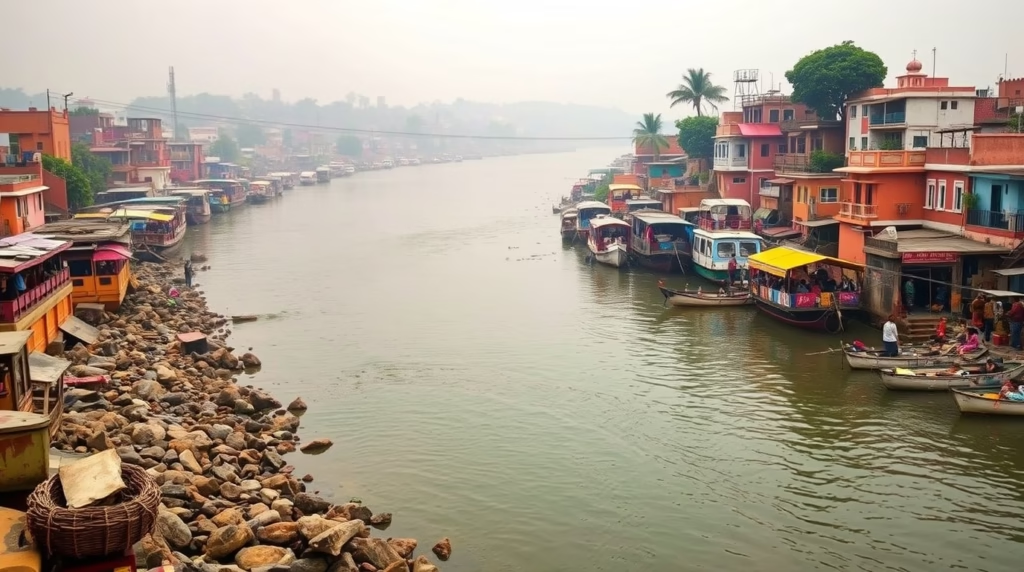The Ganga: A Living Testament to Nature’s Self-Purification
The Ganga, venerated as a sacred river in India, transcends its spiritual significance by demonstrating a remarkable, scientifically validated self-purification ability. This unique characteristic, unparalleled among freshwater rivers globally, positions the Ganga as a living laboratory for understanding nature’s intrinsic resilience. The core of this extraordinary capability lies within the river’s rich ecosystem of bacteriophages, microscopic entities that act as nature’s most efficient water purifiers.
Unveiling the Mechanisms of Self-Purification
The self-purification of the Ganga is a complicated biological process fueled by an incredible variety of bacteriophages, not just a myth. In a ground-breaking investigation, 1,100 different kinds of bacteriophages were found in the river under the direction of Padma Shri Dr. Ajay Sonkar, a well-known specialist in cell biology and genetic research. These phages, aptly named “bacteria eaters” in Greek, are viruses that specifically target and destroy bacterial cells. Their role is pivotal in maintaining the Ganga’s purity, especially during mass gatherings like the Maha Kumbh, where millions of devotees immerse themselves in the river.
The Power of Bacteriophages: A Microscopic Army
Bacteriophages, though minuscule, are formidable adversaries to harmful bacteria. They function by injecting their genetic material into bacterial cells, hijacking their cellular machinery, and replicating until the host cell bursts, releasing hundreds of new phages. This process, repeated countless times, ensures a continuous cycle of bacterial elimination. In the Ganga, this process is exceptionally efficient, with bacteriophages eliminating germs 50 times faster than in other environments.
During the Maha Kumbh, when the river experiences an unprecedented influx of human activity, these phages act as vigilant sentinels. They detect and neutralize harmful bacteria shed by millions of bathers, preventing the river from becoming a breeding ground for pathogens. Each phage, upon encountering its target, rapidly reproduces, generating 100-300 new phages per cycle, thus amplifying their purifying effect. This rapid multiplication ensures that the river’s natural defenses remain robust even under extreme pressure.
Selective Targeting: Maintaining Ecological Balance
One of the most remarkable aspects of the Ganga’s self-purification is the selective nature of bacteriophage activity. Unlike chemical disinfectants that indiscriminately kill all microorganisms, bacteriophages target only harmful bacteria, leaving beneficial microbes untouched. This selectivity is crucial for maintaining the river’s ecological balance. Beneficial bacteria play vital roles in nutrient cycling and maintaining a healthy aquatic ecosystem. By preserving these essential microbes, the Ganga’s self-purification mechanism ensures long-term ecological sustainability.
Scientific Validation and Global Collaboration
Dr. Ajay Sonkar’s research, conducted in collaboration with prestigious institutions like Wageningen University, Rice University, Tokyo Institute of Technology, and Harvard Medical School, lends substantial credibility to the Ganga’s unique properties. His expertise in genetic code, cell biology, and autophagy has been instrumental in elucidating the mechanisms of bacteriophage-mediated purification.
Scientific reports have further highlighted the alkaline nature of the Ganga’s water, which provides an optimal environment for bacteriophage survival and activity. This alkalinity, combined with the river’s unique mineral composition, contributes to its exceptional resilience against pollution.
Cultural, Economic, and Environmental Significance
The Ganga’s significance extends beyond its scientific attributes. It holds immense cultural and religious importance for millions of people in India. The river is integral to countless rituals and ceremonies, embodying spiritual purity and renewal. The Maha Kumbh, a massive religious gathering held on the banks of the Ganga, attracts millions of pilgrims and contributes significantly to the Indian economy, generating an estimated ₹3 lakh crore.
However, the Ganga’s importance transcends cultural and economic dimensions. It serves as a vital ecosystem, supporting a rich biodiversity and providing water for millions of people. Its natural ability to maintain purity despite significant human impact offers valuable lessons in sustainable water management. The Ganga’s resilience underscores the importance of preserving natural ecosystems and harnessing their intrinsic capabilities for environmental protection.

Government Response and Addressing Pollution Concerns
The Uttar Pradesh government has acknowledged Dr. Sonkar’s research, citing it as evidence of the Ganga’s inherent purity. This response was issued to counter concerns raised by the Central Pollution Control Board (CPCB) regarding the river’s water quality. The government’s stance highlights the importance of recognizing and leveraging the river’s natural self-purification abilities in addressing pollution challenges.
While the Ganga’s self-purification is remarkable, it is not impervious to the growing pressures of pollution. Industrial effluents, untreated sewage, and agricultural runoff continue to pose significant threats to the river’s health. Therefore, a comprehensive approach that combines scientific understanding with effective pollution control measures is essential to safeguard the Ganga’s future.
A Call for Stewardship
The Ganga’s unique self-purification ability is a testament to the power of nature’s intrinsic mechanisms. It underscores the importance of respecting and preserving natural ecosystems, which often possess remarkable capabilities for self-regulation and resilience. As Dr. Ajay Sonkar emphasizes, the Ganga serves as a valuable lesson in harmonious coexistence with nature.
Protecting the Ganga is not merely a matter of environmental conservation; it is a moral imperative. Future generations deserve to inherit a healthy and vibrant river, a living symbol of nature’s enduring power. By embracing scientific knowledge and implementing sustainable practices, we can ensure that the Ganga continues to flow pure and pristine, a testament to the enduring legacy of nature’s self-purification. The river’s inherent ability to cleanse itself offers a powerful message: nature, when given the chance, can heal itself, providing a blueprint for sustainable living. We must recognize and value this natural gift, ensuring its protection for the well-being of our planet and future generations.
| Feature | Ganga River | Other Freshwater Rivers |
| Bacteriophage Presence | Yes (1,100 types) | Limited or None |
| Self-Purification | 50 times faster germ elimination | No self-purification mechanism |
| Targeted Bacteria Removal | Yes | No |
| Alkaline Properties | Strong | Weak to Neutral |
| Large-Scale Human Impact | Remains germ-free despite millions bathing | Degrades quickly |
more news|| Visit Bulletinbuzzs
